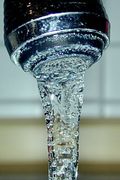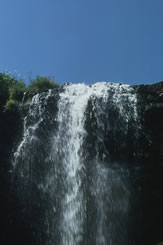 Jordan: King inaugurates Disi Water project
Jordan: King inaugurates Disi Water project
Jordan King inaugurated the multi-million-dinar Disi Water Conveyance Project, which will pump 120,000 cubic metres of water daily to fill a growing gap between supply and demand.
As water from the southern Disi aquifer started flowing into the capital’s networks, the Ministry of Water and Irrigation announced Wednesday a comprehensive plan to distribute the project’s 100 million cubic metres per year across the governorates.
Minister of Water and Irrigation Hazem Nasser said that the idea for the Disi project came about in 1991 but the scheme faced obstacles throughout the past decades due to several financial and technical challenges that delayed its implementation.
“Today is history is made as we celebrate the launch of the Disi Water Conveyance Project. We have been waiting for this day for years,” Nasser said during a ceremony held to launch the project at a main pumping station in Qastal, south of the capital on Wednesday.
Carried out on a build-operate-transfer basis by the Turkish company GAMA, a 325-kilometre pipeline was constructed to convey water from the ancient Disi aquifer in southern Jordan to Amman. The water is being transferred to Amman via a pipeline, which passes through several water stations, from Maan-Tafileh-Karak-Madaba and finally to Amman.
The Disi project involves the drilling of 64 wells, 55 of which will be used for the generation of water, whilst nine wells will serve as piezometer wells to measure the elevation of water. Forty six of the 55 water generation wells will be used for water extraction, while the remaining nine wells will be "on standby" and only used in cases of emergency.
“The project is currently pumping 5,000 cubic metres of water per hour from 23 wells. The amount is set to gradually increase as another eight wells will be ready within two weeks and the remaining wells will follow,” Nasser told The Jordan Times on the sidelines of a press conference held as part of the event.
Nasser emphasised that the project will not only supply Amman with water, but will pump water to Zarqa starting next week and to Irbid, Mafraq, Jerash, Madaba, Karak and Ajloun soon.
“The water situation in several governorates will improve because the project will pump additional water, while the governorates’ water resources will stop supplying Amman, thus more water will be available to meet local demands,” Nasser said.
The minister noted that starting Thursday, Qatraneh wells, which supply Amman with 500 cubic metres of water per hour, will stop pumping water to Amman. The water will be diverted to Karak.
“The Disi project is the largest strategic venture implemented with the cooperation of the private sector and is one of Jordan’s solutions to its pressing water crisis,” Nasser noted.
The JD702 million Disi project went into implementation in June 2009 after the financial closure was signed. The government's equity in the project totals $400 million, $100 million of which was allocated as "standby" funding, to be used if international prices of construction materials, including steel, increase. The European Investment Bank and the French Development Agency extended two $100-million soft loans to the government for the project.
“The government will pay for the company JD0.90-JD0.91 fils per cubic metre,” Nasser said.
GAMA Energy Managing Director and Board Member, Arif Ozozan, said during the ceremony that the Disi project will improve standards of living and accelerate Jordan’s social and economic progress.
Ozozan said that the timing of the launch of the project is suitable as it coincides with the start of the holy month of Ramadan, summer and the fact that Jordan is currently hosting hundreds of thousands of Syrian refugees.
Last week, the ministry started experimental pumping of water from the Disi aquifer to check the readiness of the project and to tackle any operational flaws that may emerge during this trial period.
Nasser said that lab tests have confirmed the safety of the Disi water, which has high radiation levels, noting that radioactive particles occur naturally in underground water all over the world and radiation levels vary from one well to another.
“What matters is how you deal with the radiation levels using environmentally and economically sound methods. The ministry is mixing the Disi water with fresh water from Zay Treatment Plant, Mujib and other water resources in the Jordan Valley,” he noted.
A study released in 2009 claimed that underground wells in the Disi aquifer in the south of the Kingdom have 20 times more radiation than is considered safe for drinking.
Nasser said that the worldwide average natural dose of human’s exposure to radiation is about 2.5-3 millisievert per year, highlighting that the Disi water radiation after mixing is less than 0.5 millisievert per year.
In addition, salinity levels at the Disi water were found to be 300 parts per million, while the percentage reaches 700-800 parts per million in other water resources.
“Disi water is purer than bottled water and I take full responsibility for what I’m saying,” Nasser said during the press conference.
--
Read also: Jordan readies the taps on controversial water project
http://www.emwis.net/thematicdirs/news/2013/07/jordan-readies-taps-controversial-water-project
| Contact information |
Hana Namrouqa, Jordan Times
|
|---|---|
| News type | Inbrief |
| File link |
http://jordantimes.com/king-inaugurates-disi-water-project |
| Source of information | Jordan Times |
| Subject(s) | AGRICULTURE , DRINKING WATER , ENERGY , FINANCE-ECONOMY , HYDRAULICS - HYDROLOGY , INFRASTRUCTURES , NATURAL MEDIUM , POLICY-WATER POLICY AND WATER MANAGEMENT , RISKS AND CLIMATOLOGY , WATER DEMAND |
| Relation | http://www.semide.net/countries/fol749974/country045975 |
| Geographical coverage | Jordan, |
| News date | 18/07/2013 |
| Working language(s) | ENGLISH |
 you are not logged in
you are not logged in





